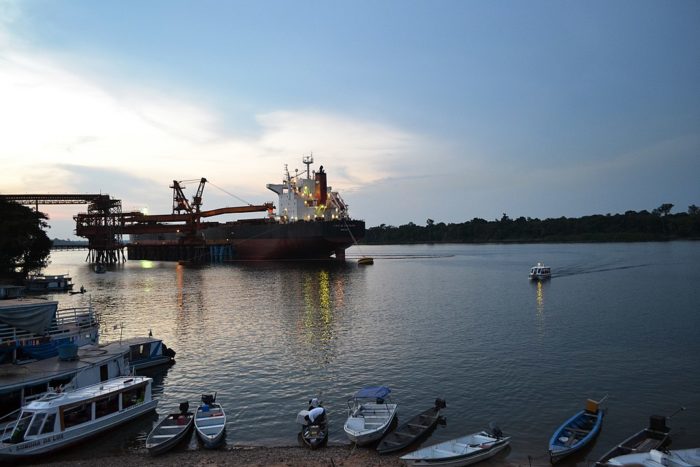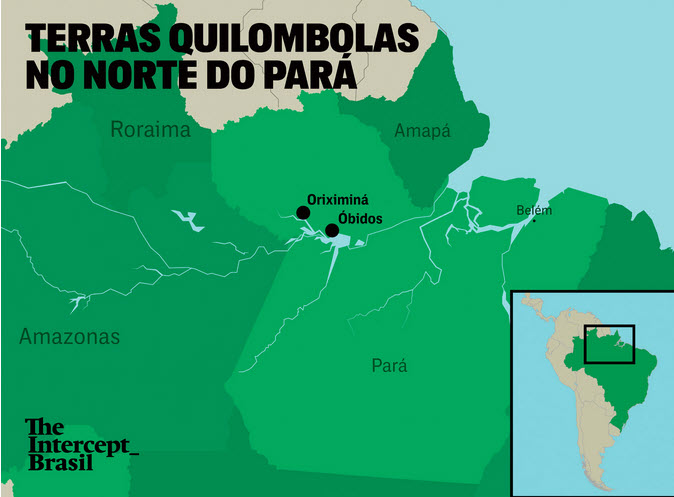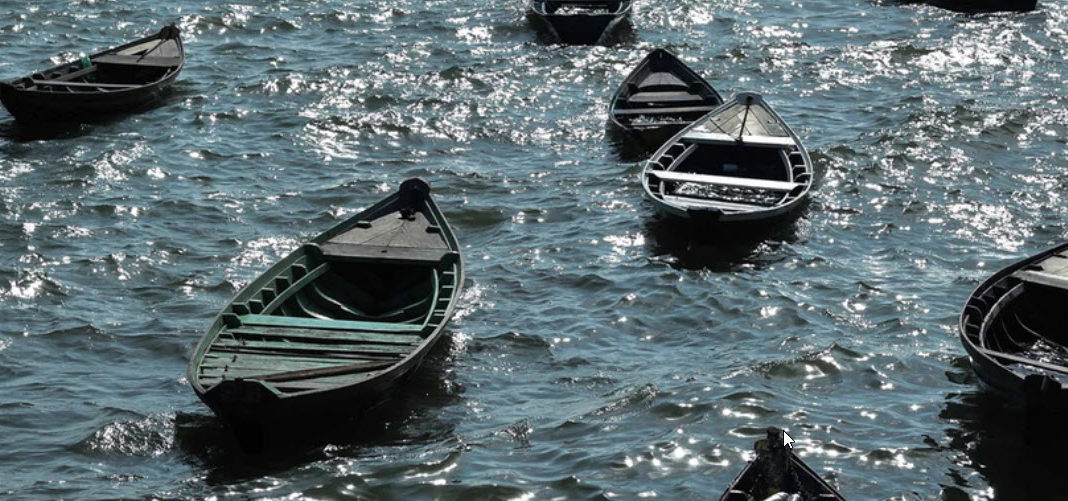This article was first published by The Intercept on 18 March. It was translated for LAB by Chris Whitehouse. You can read the original (in Portuguese) here.
LAB has added a note about quilombos and an update on the Covid-19 test results.
The main image is from The Intercept. Photo: Nelson Almeida/AFP via Getty Images
It is not only people living in towns and cities that are concerned about coronavirus. To the north of the River Amazon, in the state of Pará, a suspected case of the disease raised the alarm for traditional communities in the Amazon forest. Two employees of the mining company Mineração Rio do Norte (MRN) are confined to their home in Porto Trombetas, a company town run by Brazil’s biggest bauxite producer, which is a subsidiary of Vale.
The industrial complex is located in the municipality of Oriximiná in the middle of eleven quilombos located along the banks of the River Trombetas and surrounded by virgin forest. Quilombos are settlements founded by fugitive slaves and inhabited by their descendants – quilombolas. If we include settlements in the neighbouring municipality of Óbidos, there are 19,000 quilombolas living in the region – one of the largest such populations in Brazil. The area is remote. It is at least a two-day journey from Belem and up to 12 hours to the nearest hospital, depending on the location of the community.
“What worries me most is that our community is near Porto Trombetas, which is filled with people who are not from around here. They travel regularly, they come and go”, says Amarildo Santos de Jesus, who lives in the Boa Vista quilombo. This is the settlement closest to the mining company installations and is home to 155 families.

According to the Oriximiná Municipal Association of Descendant Quilombo Communities, around 80% of Boa Vista residents work in Porto Trombetas, mainly for companies that provide outsourced services such as cleaning, maintenance and transport to MRN. “We rely on the mining company’s own hospital and the municipal hospital. The health situation is precarious, so we think we could have a disaster on our hands”, complains Claudinete Colé, director of the association.
MRN’s press officer says that one of the company’s employees has been in isolation since Saturday, along with three family members. His test results should be available on Friday. The second suspected case entered isolation on Monday and will collect the test results on Wednesday.
LAB adds: In a press release dated 21 March, the company stated that the Coronavirus test, carried out ‘on our employee’ by Hermes Pardini Laboratory, Belo Horizonte, was negative. ‘The company reiterates the advice’, it continues, ‘given to its employees, residents in the town and surrounding communities, that they should stay at home and adopt all the hygiene practices recommended by health service institutions.’ There is no mention of a second case.
The company issued a statement advising that nobody will be allowed into Porto Trombetas until the end of March. Access by river, land and air will be closed. Employees who are on holiday or working in other regions of the county will only be able to return at that time. But the press officer said that quilombolas are free to move between the town and their communities. Administrative staff are working from home, but operational teams are working as normal. Classes and events likely to attract groups of people have been suspended.
About 6,500 people live in Porto Trombetas, all direct or indirect employees of the mining company. The town has a private airport, owned by MRN, for charter flights only. The quilombolas use the River Trombetas and its tributaries to move around in their canoes and may come into contact with residents of three indigenous reserves that lie upstream: Kaxuyana-Tunayana, Nhamundá-Mapuera and Trombetas-Mapuera.
“Porto Trombetas is a transit centre for quilombolas and indigenous people travelling up and down the river, mainly at the end and start of the month. This is when they go to the town of Oriximiná to draw pensions or maternity leave benefits”, explains Douglas Sena, quilombola and social worker for the Óbidos Diocese pastoral service, a Catholic church organisation that works with 58 quilombos in the region. Quilombolas and indigenous people also go into town to access health services, visit relations or sell produce at market. So there is a constant flow of people, which increases the risk of infection spreading to these communities.
In Óbidos, the municipality next to Oriximiná, another megaproject is endangering traditional communities by promoting contact with people from other parts of the country. In the middle of last year, the engineering company Elecnor opened an office in the municipality to conduct preparatory studies for construction of the transmission line that will carry electricity from the Tucuruí hydroelectric dam. According to Sebastião Pinheiro Cordovil da Silva, the company’s environment department manager, the office employed as many as 50 people but now employs about 30, including professionals from Rio de Janeiro, São Paulo, Brasília and Mato Grosso do Sul.

As of Friday 13 March, these employees were in contact with residents along the path of the transmission line, including the Muratubinha and Arapucu quilombos as well as nine settlements run by the National Land Reform Institute (INCRA). Only administrative work is being done at the moment. “All activities in these communities are suspended for the next 15 days and we will then review the situation. It is likely that we will extend this period”, says Cordovil da Silva.
Catarina Soares Franco is a nurse and the only employee at the health centre located in the Arapucu quilombo. The nearest doctor is in Óbidos, a 20-minute boat trip away (can be longer during periods of drought). When the coronavirus crisis broke out, she began to worry about the movement of Elecnor employees in the community. “We are worried because our region is very remote, the health structure is precarious, and and there is no reason why we shouldn’t get the virus. There has already been one confirmed case of coronavirus in Manaus, which is the nearest big city to us, nearer than Belem”. Franco points out that dozens of large passenger boats come through the town of Óbidos every week, carrying people from all over the north of Brazil.
The difficult access to health services is also what most concerns Lúcia Andrade, Executive Coordinator of the São Paulo Pro-Indian Commission, which works with quilombos in the region. She thinks that quilombolas are more vulnerable to coronavirus than the rest of the population. “Some communities are located far from the big cities and people may have a twelve-hour boat trip to get to a health centre”, she says.
According to the Brazilian Infectology Society, it is estimated that five per cent of people infected by coronavirus will require admission to an intensive care unit (ICU). According to Agência Pública, the North and Northeast regions of Brazil have the lowest number of beds per capita in the country. In Pará, only the Belem region is within the range recommended by the World Health Organisation of between one and three beds per 10,000 inhabitants.
For residents of the Óbidos and Oriximiná quilombos, the nearest ICU is at the Baixo Amazonas Regional Hospital in Santarem, which has 49 intensive care beds for adult, paediatric and neonatal patients in the region’s 20 municipalities. So, for example, a resident of the Alto Trombetas quilombo would have to travel almost ten hours to a hospital in Oriximiná and a further eight hours in a passenger boat to get to Santarem, an 18-hour journey, to get to an ICU.
In addition to the distance from health centres, Andrade emphasises the risk factor posed by poor basic sanitation. The great majority of communities only have a cesspit, which can flood in the rainy season. Drinking water is often drawn directly from the river and untreated. In the best-case scenario, families draw water from a well. Another risk factor is the lack of information about the pandemic. Internet access is still a luxury in the region and electricity supply depends on diesel-powered generators, which are switched on for a few hours at night.
I tried to contact the local authorities in Óbidos and Oriximiná, but without result at the time of writing. So far, Pará has one confirmed case of the disease. In the North Region, there are also reports of cases in Amazonas and Tocantins.

Indigenous peoples fear the virus will cross the border
Even further away from the big cities is the Tumucumaque indigenous reserve. The territory is more than 400 km to the north of the quilombos and on the border with Suriname. It is only accessible via a two-hour journey in chartered plane from Santarem. But there is concern about coronavirus even there. The indigenous peoples carry the memory of the thousands of family members who died from diseases brought by the whites. “For us, a cold can become an outbreak. So just imagine coronavirus”, says Aventino Nakai Kaxuyana Tiriyó, president of the Tiriyó, Kaxuyana and Txikuyana Indigenous Peoples Association, in Aptikati.
The main concern is a confirmed case in a village of the Tiriyó ethnic group in Suriname, a three-day journey on foot from the Tiriyós mission, which is the biggest village in Tumucumaque, with 200 people. “For us, this is close. It is common for people in Brazil to visit relations in Suriname and vice versa”, explains Aventino. It is also common for indigenous peoples from the Tiriyós mission to visit relations in the other 56 villages in Brazil itself, where more than 3,000 people live.
Aventino is also worried about the presence of military personnel at air force and army bases established in the territory in the 1960s. There are military personnel from Manaus, Macapá and Belem, rotated every two months. In addition, about 100 indigenous people live permanently or temporarily in Macapá, including Aventino himself.
Aventino thinks the main problem is how to let relations know what they need to do to protect themselves, without putting them at risk. “Internet access is only available at the Tiriyós mission, not in the other villages. The main way of communicating is the radio, but the information broadcasted is always a bit unclear. It is a challenge to do what we need to do without increasing the risk to the community”.
Denise Fajardo is a founding member of the Indigenous Research and Education Institute (IEPE), which runs training courses for the people of Tumucumaque. She says it is an illusion to think that indigenous peoples are isolated and therefore safe from coronavirus. “People move back and forth between the villages and towns, and also between countries. indigenous people in Brazil, in Amapá and northern Pará, have regular contact with relations in French Guiana, Suriname and Guyana”.
To try to contain the spread of coronavirus among indigenous peoples, the National Indian Foundation (FUNAI) issued a decree on 17 March restricting access of its employees and other civilians into indigenous territories. The decree suspended authorisations for access to these territories, except for the providers of essential services and health workers. The Special Secretariat for Indigenous Health at the Ministry of Health has launched a National Contingency Plan to Combat Human Infection by the New Coronavirus among Indigenous Peoples.
Both IEPE and the São Paulo Pro-Indian Commission have cancelled field work and other activities with traditional communities. Meanwhile, indigenous organisations, including the Coordination of Indigenous Organisations of Brazilian Amazonia, are issuing explanatory bulletins about coronavirus,. These organisations have suspended travel and other activities.

